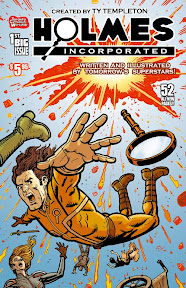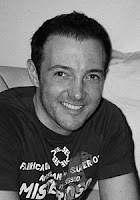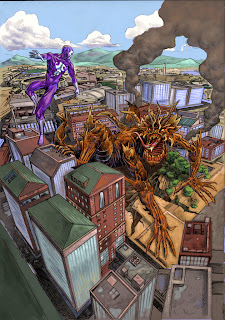 |
| Vicky Stonebridge at work |
Scottish Highlands-based Vicky Stonebridge describes herself as "an artist, firefighter, youth worker, convention organiser, and other things!
"I think living in remote rural North West Scotland has caused this chaos," she says. "It’s always been necessary to duck, weave and multi-task to stay afloat. I do whatever is required, with whatever is to hand.
"I was also a single mum for 20 years -- which gives me a determination and pragmatism. I clashed with art college tutors who didn’t approve of my fantasy and figurative work, so studied Ceramics instead of painting and missed out on life drawing/ anatomy but gained a practical skill and avoided the fine arts elitism.
 |
| Among the Waves by Vicky Stonebridge |
"Stressed out with a chaotic life I turned to anti-establishment politics, ‘druidism’ and living on the road in the late 1980’s: I may cringe at the memory from the cynical sidelines of 2010 but this period laid the important foundations of themes which I still pursue today."
So it's not so much that Vicky was late to the digital art/ fantasy & sci-fi art party it's that she had to take a 20-year detour with three children, a bag of clay, sack of firewood, chainsaw, pan of lentil soup and a pack of dogs on her back.
"When I arrive at the party it turns out I’m at the wrong party, in the wrong era, wearing the wrong costume and I don’t speak the language, but hey it's a brilliant party anyway!" she laughs. "So I paint realistic looking landscapes and shortbread tin subjects for the local galleries because I need to eat. I paint fire fighters, because its mad fighting fires and dealing with car smashes with an artist’s eye, and because I can.
"I make things because things because it’s a compulsion. I draw and paint imaginary characters, fantasy, comic’s art because it’s a challenge, and because there are a pantheon of ideas and characters fighting to get out of my head. I run workshops and master classes, in comic art, recycled crafts and anything in between - because working with people is inspiring, keeps me on my toes and there’s nothing like the buzz of enabling creativity in others."
SciFi Art Now: What tools do you mainly use to create your art?
Vicky Stonebridge: Photoshop for digital work, for traditional - Acrylic paint, watercolours, coloured inks, sticks and glass, found objects, whatever is to hand.
SciFi Art Now: Why?
Vicky: I was late to learn Photoshop, I just didn’t have a fast enough PC or time to play. I still feel I’m scratching at the edges, but for illustration work it gives me more flexibility and speed. I’d have to work on canvas for weeks to achieve the same luminosity and depths.
However you can’t beat traditional materials, I like to work with both at the same time as they feed each other. I use Acrylics like PS layers building up opacity and texture gradually.
SciFi Art Now: What inspired you to become an artist?
Vicky: I think I first stated this intention aged 5 -- possibly earlier. The compulsion to create is innate. Every so often I think I should grow up and get a job that actually pays the bills, but life has been hard and it's taught me that now at my age, I’ve earnt the right to do what I want to do, which is front line real hands on art jobs no matter how tempting those salaries of art establishment project managers look.
SciFi Art Now: What was the most useful piece of advice you were given when you began learning your craft?
Vicky: Mostly I feel like I’m fighting all the un-useful things people have said! I'm spurred onwards by every rejection, snub or sneer. But my School art teacher had faith in me and encouraged me to keep going, He once said 'You must paint a thousand real trees before you can attempt a fantasy tree'. Then we struck a deal that he’d let me do one fantasy piece a term if I did all the boring still life’s the curriculum required.
SciFi Art Now: Which artists most inspire you?
Vicky: Most of the Pre-Raphaelite brotherhood, John W Waterhouse. Arthur Rackham, Brian Froud, folk art, discovering new artists like Viktor Vasnetsov. Various comic artists, for example Simon Davis for his painterly approach, loose brushwork and accurately observed characters. But really if I need a boost I just go outside and look at the mountains, trees, waterfalls or of course there are my trusty books of Celtic, Pictish and Scythian art.
I try to look at things differently, for example if I am drawing a horror comic I will avoid looking at other horror comic artists as their images will fill my head and stop my own interpretation getting out.
SciFi Art Now: What is the appeal to you of science fiction as an inspiration for some of your work?
Vicky: When I was seven, I found a Sci-Fi anthology in the school library, with stories by Isaac Asimov, Poul Anderson, H.G.Wells, Phillip K.Dick and others. I was transported into those worlds long long after the teacher took the book off me as I was too young to understand it.
 |
| After the Snow by by Vicky Stonebridge |
Sci-Fi, like (good) fantasy, westerns, and comics, strips away all that’s depressing, oppressing, vacuous and superficial in our real modern world. While SF writers may of course satirise the rubbish around us they evoke places where people are stripped back to core values, heroes, villains, quests, adventures, redemption, love and discovery.
Adventures are quite hard when there’s CCTV on every corner, the council tax needs paying, a risk assessment filling in, reality TV show to watch, products to consume at tescos and peer pressure to conform to. Sci-fi is more than escapism; it is free enough to reinvent ourselves, our society, to envision alternatives, to lead us boldly into potential futures. For my work I like to take the real, the historical, the possible and just nudge it sideways a little.
SciFi Art Now: Do you have a favourite piece of work or project you have worked on?
 Vicky
Vicky: It’s always the next piece I’m working on as nothing is ever good enough. This picture was I think the second that I did in digitally & I like the looseness and texture I managed to get in there. It was for a
2000AD message board monthly competition ‘
Into the Heart of the Sun’
SciFi Art Now: In your career, have you had any bizarre experiences while creating your art (cats walking across a canvas, like Roger Dean once did, for example)?
Vicky: Cats will do that sort of thing, chewing the corner of the work, jumping up on it, plenty of that, I had hens, ducks and goats at my last house, so yes there was always animal hi-jinks if they broke into the studio.
 |
'Damping Down' by by Vicky Stonebridge
- one of several pieces inspired by Vicky's
work as a firefighter |
There is nowadays the joy of getting a fire call out mid brush stroke. My chaotic permanently interrupted lifestyle has given me a rather five minute concentration span methodology. I’m lost if there isn’t chaos or a crisis to attend to.
SciFi Art Now: What most frustrates you about being an artist?
Vicky: Everything? My middle name is artistic frustration.
Elitism, snobbery, genre definitions, the limited market place, lack of money, lack of time, lack of freedom (see all the other frustrations), art hierarchies, the limited methodology of art understanding and teaching in UK establishments, limited understanding of art in general public, lack of general arts education, lack of funding, lack of materials, lack of support, my own shortcomings in anatomical understanding, the dog harassing the postie when I’m trying to focus, my deteriorating eyesight, cat jumping on the wacom, bad lighting and no heating, stupid uncomfortable chair, no space and basically not enough hours in the day.
No matter how much I try and cut out all the voluntary work, admin, PR work I still spend 95 per cent of my freelance time doing work that isn’t actually art. Argh!! It's just the way I’m programmed, a little driven, that cranky edge is a good motivator.
SciFi Art Now: What keeps you going despite the hopefully occasional frustrations?
Vicky: Creativity is not a choice, it is bigger than me, whether what I make or draw is any good or not it simply must out. It pulls me forwards and is the only thing that makes sense of anything. It's communication between the inner world of mind and the outer world of other people, communication requires discipline and thought -- otherwise fingerpainting and making mud pies would be sufficient fun to stay sane... Mind you, I might get more kudos from the arts establishment if I stuck to mud pies, mud pies with cats paw prints in.
SciFi Art Now: What advice would you offer to anyone starting out as an artist?
 Vicky
Vicky: Accept criticism from people who know what they’re talking about, pay less attention to family, friends and the bloke across the road who “knows what he likes and that’s a bit weird innit?”.
Bounce back from rejections, there are millions of people out there doodling, forget your ego and work hard to find what it is that makes you different. Draw, draw, draw, copy images you like, study artists from other genres, traditional fine art, anything -- go to life drawing classes; draw anything and everything all the time.
Finally, follow your instinct and create in the way you want to, not what you think people want to see and not what you think you can get away with because it avoids drawing things you find difficult. Never mind if it doesn’t fit in any boxes and if the artist making mud pies wins all the prizes.
• Check out more of Vicky's work at www.balnacra.com or balnacra.blogspot.com. Contact Vicky via pottery@balnacra.com
 Gibson Quarter is best known for his illustration work on War on Drugs strips with writer Alan Grant, in the adult comics magazine Wasted. He's also drawn stories for numerous other European magazines and comics including Northern Lightz, FutureQuake, Something Wicked, Zarjaz and Dogbreath. In North America, he's provided art for Holmes Inc with Ty Templeton, and the upcoming 7th Wave #1.
Gibson Quarter is best known for his illustration work on War on Drugs strips with writer Alan Grant, in the adult comics magazine Wasted. He's also drawn stories for numerous other European magazines and comics including Northern Lightz, FutureQuake, Something Wicked, Zarjaz and Dogbreath. In North America, he's provided art for Holmes Inc with Ty Templeton, and the upcoming 7th Wave #1. 


 • Check out more of Gibson's work at: http://gibsonquarter27art.blogspot.com. Contact him by email via gibsonquarter27ATyahoo.com
• Check out more of Gibson's work at: http://gibsonquarter27art.blogspot.com. Contact him by email via gibsonquarter27ATyahoo.com











































